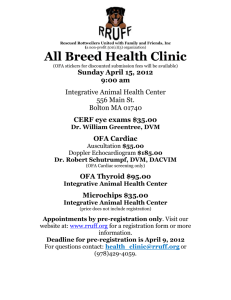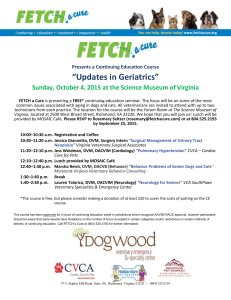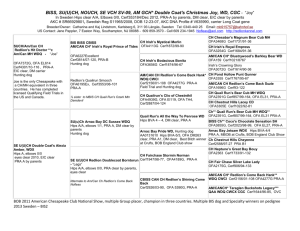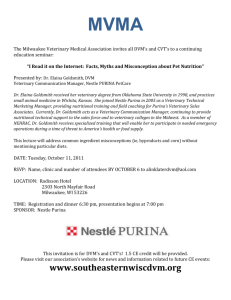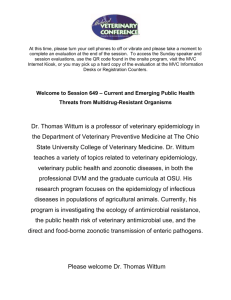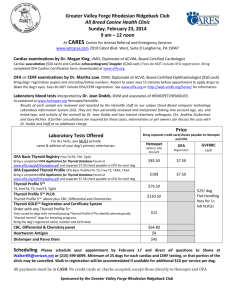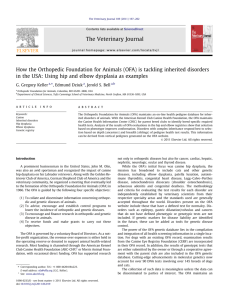Nathan Nelson, DVM, MS, DACVR
advertisement
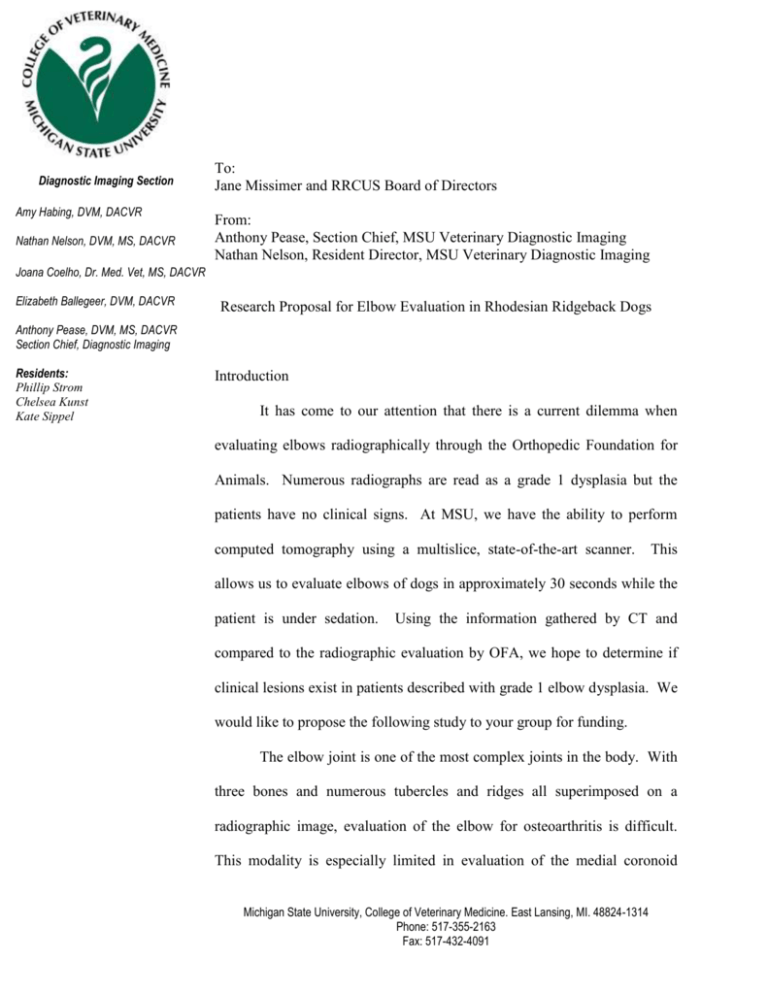
Diagnostic Imaging Section Amy Habing, DVM, DACVR Nathan Nelson, DVM, MS, DACVR To: Jane Missimer and RRCUS Board of Directors From: Anthony Pease, Section Chief, MSU Veterinary Diagnostic Imaging Nathan Nelson, Resident Director, MSU Veterinary Diagnostic Imaging Joana Coelho, Dr. Med. Vet, MS, DACVR Elizabeth Ballegeer, DVM, DACVR Research Proposal for Elbow Evaluation in Rhodesian Ridgeback Dogs Anthony Pease, DVM, MS, DACVR Section Chief, Diagnostic Imaging Residents: Phillip Strom Chelsea Kunst Kate Sippel Introduction It has come to our attention that there is a current dilemma when evaluating elbows radiographically through the Orthopedic Foundation for Animals. Numerous radiographs are read as a grade 1 dysplasia but the patients have no clinical signs. At MSU, we have the ability to perform computed tomography using a multislice, state-of-the-art scanner. This allows us to evaluate elbows of dogs in approximately 30 seconds while the patient is under sedation. Using the information gathered by CT and compared to the radiographic evaluation by OFA, we hope to determine if clinical lesions exist in patients described with grade 1 elbow dysplasia. We would like to propose the following study to your group for funding. The elbow joint is one of the most complex joints in the body. With three bones and numerous tubercles and ridges all superimposed on a radiographic image, evaluation of the elbow for osteoarthritis is difficult. This modality is especially limited in evaluation of the medial coronoid Michigan State University, College of Veterinary Medicine. East Lansing, MI. 48824-1314 Phone: 517-355-2163 Fax: 517-432-4091 process, a bony prominence of the ulna, which is one of the primary sites of disease in animals with elbow dysplasia. Computed tomography provides a cross-sectional image of the bones as well as allowing for 3D reconstructions to better see anatomic detail without superimposition. It is currently our gold standard to evaluate bone lesions due to the high amount of detail and small slice thickness, and has the ability to directly image the medial coronoid process. Our hypothesis is that radiographic evaluation of the elbows in Rhodesian Ridgeback dogs are graded more severely than CT evaluation of the elbows due to superimposition and the effects of radiographic technique. Materials and Methods To test this hypothesis, twenty dogs would be enrolled in this study. All dogs will have elbows previously evaluated by OFA. Ten of these dogs will have received grade 1 elbow evaluations by OFA and ten of these will have no abnormalities determined OFA. Physical examinations will be performed by a veterinarian prior to administration of sedation, to ensure there are no abnormalities that would preclude the administration of sedatives. At the time of presentation to MSU, we will acquire flexed lateral elbow radiographs (the traditional OFA projection) then immediately perform a CT scan on all dogs. Dogs will be sedated with a combination of dexmedetomidine and butorphanol (or other suitable drug combination if a patient has had previous reactions to either of these drugs). Atipamezole will be administered after the imaging procedure to reverse the effects of the dexmedetomidine and allow faster patient recovery. Dog owners will be presented with a waiver acknowledging their willingness to participate in the study as well as an understanding of the inherent risks of sedation administration. Michigan State University, College of Veterinary Medicine. East Lansing, MI. 48824-1314 Phone: 517-355-2163 Fax: 517-432-4091 Standard CT parameters will be used for all examinations to ensure the highest possible scan quality: 0.625 mm slice thickness, smallest field of view possible to include each elbow individually (10 cm or less), bone algorithm image reconstruction, and 120 kVp and 200 mAs technique settings. We will then submit the radiographs to OFA for evaluation. The CT scans will be independently evaluated by 2 board certified radiologists MSU and graded on a scale of 0-3, with parameters generally similar to OFA. Grade 0 elbows will have no detectable evidence of disease. Grades 1-3 elbow disease will have progressive increases in periarticular osteophytosis (arthritis) and medial coronoid process sclerosis and fragmentation. These grades will then be compared to the OFA findings to determine if inconsistencies exist. This data will be statistically analyzed using a rank-sum analysis with significance set at p < 0.05. In addition, the interobserver variability (the difference between the two radiologists looking at the images) will also be statistically analyzed using kappa statistics. A summary of qualitative differences between radiographic and CT findings will also be generated. This pilot study would provide a basis to continue this work on a larger population of dogs if we find that inconsistencies exist. Radiologists at MSU evaluating the CT scans will blinded to the results of the radiographic examinations for each animal. Similarly, technologists performing the examinations will be blinded to the previous OFA results for each animal. A study coordinator will be responsible for maintaining the blinded status of each radiologist and technologist, and will be the person in charge of communicating imaging results to each owner. Confidentiality of results is of the utmost importance and will be maintained by our facility. The cost for this procedure will be $400 per dog for a total cost of $8000. Each animal will be received, have radiographs of the elbows that will be submitted to OFA, sedation, CT Michigan State University, College of Veterinary Medicine. East Lansing, MI. 48824-1314 Phone: 517-355-2163 Fax: 517-432-4091 scan and will be discharged from the hospital the same day, at no cost to the owner. Ideally, the cases will be animals that have been tested by OFA prior to the study to minimize the risk of insufficient sample size. The hope is that this information will be the basis to request funding through the American Kennel Club for a larger, multi-institutional study. Thank you for your consideration of this proposal and if you need more information, more details or would like to talk about the proposal, please do not hesitate to contact us at 517353-5420. Sincerely, Nathan Nelson, DVM, MS, DACVR Michigan State University College of Veterinary Medicine nelso329@cvm.msu.edu Anthony Pease, DVM, MS, DACVR Michigan State University College of Veterinary Medicine Michigan State University, College of Veterinary Medicine. East Lansing, MI. 48824-1314 Phone: 517-355-2163 Fax: 517-432-4091
